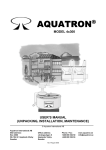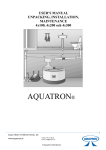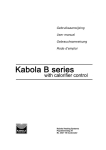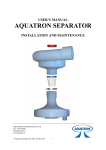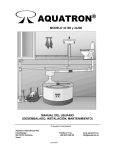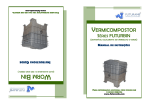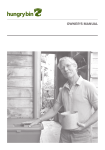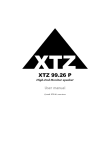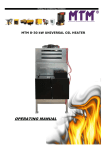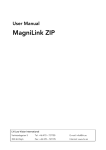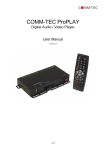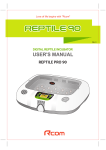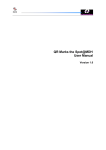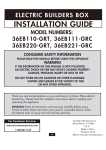Download Aquatron 4x100 Installation Manual
Transcript
AQUATRON ® MODEL 4x100 AND 4x200 USER’S MANUAL (UNPACKING, INSTALLATION, MAINTENANCE) © Aquatron International Aquatron International AB Lisselberga 1 SE-725 93 Vasteras Sweden Teléfono / Fax: +46 (0)21-560 20 June 2007 www.aquatron.se [email protected] Table of contents Item Page 2 Table of contents, table of pictures 1 Introduction 3 2 Unpackning 4 3 Preparations 4 4 4.1 4.2 4.3 4.4 4.5 4.6 Installation of the Aquatron system Arrangement of the Bio Chamber Installing the Separator Installation of the UV unit Waterseal alternatives Pipe installation Flushing test 4 4 4 5 5 5 6 5 5.1 5.2 Composting Startup Vermi composting 6 6 6 6 6.1 6.2 Special solutions Pumping Urine diversion 6 6 6 7 7.1 7.2 7.3 7.4 7.5 7.6 7.7 Maintenance instructions for the Aquatron 4x100 / 4x200models The monitoring of an Aquatron system in use Separator Maintenance and drainage of the Bio Chamber Composting Vermi composting Emptying the Bio Chamber Changing of UV light tubes in the UV unit 12 12 12 12 12 12 12 13 8 8.1 8.2 8.3 8.4 8.5 8.6 8.7 Error Checking Wet bio-bed Odour in the room Odour when windy Stoppage in the Separator Stoppage in the fluid outlet of the Separator Stoppage in the fluid outlet of the system Flies in the Bio Chamber 13 13 13 13 14 14 14 14 Table of pictures Picture: 1 2 3 4 5 6 7 8 9 10 11 12 2 Aquatron 4x100 / 4x200 installation measurements Aquatron 4x100 / 4x200 installed on a platform Outline of an Aquatron 4x100 / 4x200 platform Separator installation UV unit placed on consoles fixed to the wall Platform for UV unit Suggestion for a waterseal Connecting Separator and inlet pipe in coupler double socket Pitching of inlet pipe from WC to Separator Angled double socket for inlet pipes longer than 1 metre Some examples of horizontal pipe bends Example of Aquatron 4x100 / 4x200 installed with a pump June 2007 Page 6 7 7 8 8 9 9 9 10 10 11 11 1. INTRODUCTION IMPORTANT! For optimal functionality it is very important that this installation manual and the maintenance instructions are being followed closely. In case of problems please contact the main supplier. This is how it works – the solution is given by nature itself! The liquid is flushed to a separator where urine and water is separated from faeces and paper. The liquid will then pass through an Ultra Violet unit and may thereafter be infiltrated into the ground or into a suitable receptacle. The solid waste is being composted in a Bio Chamber. If so wished, composting worms may be added in order to accelerate the composting process. 1. Aquatron uses standard Water Closets (flushing volume 3-6 litres) or special models where the urine is mechanically diverted from the flushing water and the solid waste in the bowl itself. 2. When the toilet is flushed, the contents of the bowl are transported to the Aquatron Separator where approx. 98% of the liquid fraction is separated by using the momentum of the flushing water, centrifugal force and gravity. The Aquatron Separator needs no moving parts. 3. The solid waste (paper and faeces) falls down into the Bio Chamber where it is composted by bacteria and, if desired, by worms. If using worms, the volume of the solid waste will be reduced by approx. 90%. The need for emptying and handling the waste is therefore reduced to a minimum. Optionally, after installing an Aquatron System, some 250-300 worms are placed into the Bio Chamber. The number of worms needed to maintain the composting process will be adjusted automatically by nature. Optimal temperature for the composting is 12-25 degrees Celsius, a temperature level recommended for year-round inhabited homes. Freezing will kill the worms. The composting process is free from odour and flies because the Bio Chamber is ventilated and the small amount of liquid following the paper down into the Bio Chamber is removed by a drain at the base of the Bio Chamber. When the Aquatron 90 and 400 models are emptied, the refuse must be composted to soil in the garden together with the normal garden and kitchen waste. However, the models 4x100 and 4x200, require no further composting. 4. The liquid proceeds to the UV unit where it is exposed to Ultra Violet light which kills bacteria and viruses. The liquid may then be treated as Grey Water (bath, dish washing and laundry water) which means that the toilet wastewater may be infiltrated into the ground or into a suitable receptacle. Since the liquid fraction is separated from the solid waste, Aquatron Systems are not sensitive to peak load usage. Congratulations to your decision to buy the biological toilet system Aquatron! Our experiences from many satisfied customers during more than 20 years is that a correctly installed and properly maintained Aquatron system will serve you and your guests well for many years to come. Henry Steffensen Managing Director, Aquatron International, Amberes AB June 2007 3 2. UNPACKING The following parts are packed into the Bio Chamber: Separator, hose clip to fix the Separator parts together, Wire-ring, a branch to be attached to the Bio Chamber outlet, a connection pipe between the Separator and branch, 90o Coupler double bend socket connecting the Separator and branch, turning pole and, provided the UV unit is included in the delivery, a UV unit and a Waterseal to be attached to the UV unit (for model 4x100 possibly as a separate package). For pitch changes of inlet pipes a special angled coupler double socket is provided. A mosquito net for the top of the vent pipe is also being included. 3. PREPARATIONS To install the AQUATRON toilet system you will need the following material in addition to the WC. Components marked with an asterisk (*) are included in the shipment. Other items are to be purchased locally if necessary. PIPES: WC – Separator 4" Bend x 90º to WC 4” Coupler double sockets 4” x #” x 45o 4” Angled coupler double socket (*) 4” Pipes Separator – UV unit 2” Connecting pipe (*) 2” Soil pipe single branch (*) 2” Coupler double socket 90o bend (*) UV unit – Grey Water sewage Waterseal (*) 2” Coupler double sockets 2” Pipes MISCELLANEOUS: (purchase separately) INSTALLATION OF THE AQUATRON SYSTEM 4.1 Arrangement of the Bio Chamber 4.1.2 4.1.3 4.2 4.2.1 4 For the fluid outlet of the Separator For the fluid outlet of the Bio Chamber Connecting the two pipes above P-waterseal, part of the UV unit Amount depending on installation Outlet pipes as needed Course bark grinds approx. 50 litres (10-12 litres per compartment), Grounded 230 V outlet for the UV unit, Material for platform and consoles, 2" pipe and coupler sockets for vent pipe (WC ventilation), 45o bend to be installed at inlet in the UV unit if a pump is installed between Bio Chamber and UV unit. 4. 4.1.1 Soil pipe bend socket Amount depending on installation Soil pipe single branch for 3-4” (=#) vent pipes For 4% change of inlet pipe pitch Inlet pipes as needed Build a platform for the Bio Chamber. For measurements see Figure 1, for overview, see Figure 2. For platform, see Figure 3. Place the Bio Chamber steadily on the platform. Check the compartment where the system is to be installed. If low pressure occurs (e g if an oilburner is installed), a separate room must be built for the Bio Chamber. The room must have a ventilator to the outside air and the door should be sealed by a strip seal. The Aquatron system should be installed in a frost free compartement where: - optimal composting temperature is minimum 12° C (55° F), - at year-round living or vermi composting a temperature above 15° C (60° F) is recommended, - if necessary, insulate the compartment and install a themostat controlled electric heater. If the system is installed in a vacation house which is closed during the winter season, special precautions must be taken. Installing the Separator Put together the upper and lower parts of the Separator. Check that the Wire-ring is fully pushed down into the Separator neck and that the wires are not crossed. The upper part of the Separator (Cyclone) should rest upon the Wire-ring. Tighten the hose clip just as much as needed to keep the June 2007 upper and lower parts of the Separator together. There must be no space between the Cyclone and the Wire-ring, see Figure 4. 4.2.2 4.2.3 4.3 4.3.1 4.3.2 4.3.3 4.3.4 4.3.5 Place the Separator on the Bio Chamber. Turn it so that the fluid outlet located in the bottom part faces towards the outer side of the Bio Chamber; see Figure 2. Turn the upper part of the Separator towards the pipe coming from the WC. Tighten the hose clip. The Separator must be installed in a vertical position, see Figure 4. Installing the UV unit The UV unit should be positioned in such a way that the waste water from the Separator and the Bio Chamber can flow freely into the UV unit. It is recommended that the UV unit is placed on consoles fixed on to the wall, see Figure 5, alternatively the UV unit may be placed on small platform, see Figure 6. Make certain that the aluminium lid is positioned in such a way that it can be removed for accessing the UV fixture when replacing burned-out UV light tubes, for inspection, cleaning of the interior of the UV Unit etc. The UV unit must have its bottom surface horizontally installed. The 2” Waterseal should be installed underneath the UV unit, see Figures 1 and 2. The UV unit should be connected to a 230 V grounded outlet. Germicidal UV-C light tubes are made by: - PHILIPS, type TUV 15 WARNING! Do not expose your eyes or skin - OSRAM, type HNS to direct UV light. 4.4 Waterseal alternative If the Aquatron system was ordered without a UV unit, a waterseal must be installed between the branching pipe outlet and the Grey Water outlet. The waterseal is needed to prevent bad smell from the Grey Water outlet to enter the toilet system (Bio Chamber). Suggestion for waterseal, see Figure 7. 4.5 4.5.1 Pipe installation Use 4” pipes between WC and Separator. For ventilation use 3-4” pipes. NOTE! Only WC should be connected to the inlet of the Aquatron Separator. Separate pipes should be used for sewage from bath, kitchen, laundry etc. If these pipes are to be connected, it should be done after the Aquatron system. 4.5.2 4.5.3 The Separator should be connected to a 4” double socket. NOTE: The Separator must be horizontal and its vertical line (Figure 4) perpendicular to the Bio Chamber. The inlet pipe must be fully inserted into the socket. See Figure 8. The horizontal distance between the WC and the Separator must be minimum 1 metre and that last metre (closest to Separator) should be pitched at 5% (5 cm), see Figure 9. At further distances the earlier part of the pipe should have a 1% horizontal slope, or as national standards. If needed, use the special angled coupler double socket in order to achieve the pitch transition, see Figure 10. NOTE: Turn the color mark of the angled coupler double socket downwards. Furthermore, check that the inclination of the inlet pipe is smooth and that there are no depressions where fluid waste may gather. NOTE! Do not use a vacuum-valve. The toilet ventilation must have a separate vent pipe extending over the roof and must not be connected to the other sewer ventilation of the house, as this may cause problems with odour and flies. 4.5.4 4.5.5 4.5.6 4.5.7 The ventilation should be installed between the WC and the Separator. The ventilation pipe should extend above the roof. If there is a large level difference between the WC-outlet and the Separator, then first install the horizontal pipe pitched at the specified angle, and then make the necessary level adjustment with the vertical pipe, see Figure 1. The pipe installation from Separator to Bio Chamber and further on to the UV-unit/sewer is shown in Figure 2. If needed the connecting pipe between the Separator outlet and the branch may be shortened. The angled part of the branch which is connected to the Bio Chamber socket may be shortened if needed. To extend the Separator outlet to the connection pipe a 12 centimetres 2" pipe with a coupler may be included. If horizontal bends are needed on the Separator inlet pipe, see Figure 11. June 2007 5 4.6 Flushing test Ask someone to flush the WC with water only and check how much water is entering into the Bio Chamber. If correctly installed, when flushing with water only, a maximum of 0.5 decilitres should go that way. If too much water enters into the Bio Chamber there are two explanations: 4.6.1 If the water enters the Bio Chamber at the beginning of the flushing the velocity of the incoming fluid is too high and the pitch is too large – decrease the pitch of the inlet pipe. 4.6.2 If the water enters the Bio Chamber at the end of the flushing the velocity of the incoming fluid is too low and the pitch is too small – increase the pitch of the inlet pipe. 5. COMPOSTING 5.1 Start up Drainage of the Bio Chamber: Spread a 4-6 centimetre course bark grinds layer (NOTE: Not peat moss!) into each composting compartment of the Bio Chamber. The bark grinds should be evenly spread at the bottom of each compartment. Add some compost from the garden in order to insert microorganisms. By this the composting process will get a more rapid start. 5.2 Vermi composting See Item 7.5. 6. SPECIAL SOLUTIONS 6.1 Pumping: A pump can be used in order to save approximately 150 mm of required installation height, or when the grey water outlet level from the house is higher than the fluid outlet from the UV unit, see Figure 12. Urine diversion (Urine sorting/Urine separation): Urine sorting WCs may be connected to Aquatron toilet systems. Please contact Aquatron International for more information 6.2 Figure 1: Aquatron 4x100 / 4x200 installation measurements 6 June 2007 Figure 2: Aquatron 4x100 / 4x200 installed on a platform Component list: (all measurements in millimetres) 4x100 4x200 A 900 1050 B 800 950 1. Top boards, 3 items 120 x 34 x A (length) 2. Sideboards, 8 items 95 x 22 x B (length) 3. Legs, 4 items 95 x 95 x 200 Figure 3: Outline of an Aquatron 4x100 / 4x200 platform June 2007 7 Figure 4: Separator installation Figure 5: UV unit placed on consoles fixed on to the wall 8 June 2007 Material: (all measurements in millimetres) 1. Sideboards, 4 items A: 95 x 20 x 300, 3 items B: 60 x 20 x 300, 1 item 2. Legs, 4 items 80 x 80 x 120 3. Sideboard lowered 55 mm To provide space for a 50 mm pipe from the outlet underneath the UV unit Figure 6: Platform for UV unit Figure 7: Suggestion for a waterseal Figure 8: Connecting Separator and inlet pipe in coupler double socket June 2007 Figure 9: Pitching of inlet pipe from WC to Separator Figure 10: Angled double socket for inlet pipes longer than 1 metre 10 June 2007 Figure 8 Figure 11: Some examples of horizontal pipe bends The pump should be installed between the fluid outlet of the Bio Chamber and the inlet of the UV unit. NOTE: To avoid the fluid to splash on UV light tubes and its fittings a 45° pipe bend should be attached on the inlet pipe on the inside of the UV unit. The bend will direct the fluid towards the bottom of the UV unit. A reduction pipe 50 mm to 40 mm and the 45° pipe bend is to be bought separately. Figure 12: Example of Aquatron 4x100 / 4x200 June 2007 11 installed with a pump 7. MAINTENANCE INSTRUCTIONS FOR THE AQUATRON 4x100 / 4x200 MODELS 7.1 The monitoring of an Aquatron system in use It is recommended that an Aquatron system in use should be inspected at two week intervals (approximately). By discovering possible disturbances at an early stage (and to correct them immediately), corrections can be made more easily as compared to cases where a minor disturbance over time have “built” up to a major functional disturbance. The Items 7.2 – 7.7 below give advice about checks and measures for such regular inspections. In Item 8 a special Error Check List is also included. 7.2 Separator On the top of the Separator is an inspection lid. Occasionally paper may get stuck in the Wire-ring. Open the lid and push the paper down by using a stick or a small pole. Too soft paper may “felt” too soon and there is then a risk that it may stick to the wires which may cause too much water to fall into the Bio Chamber. To avoid this it is recommended that you switch to another type of toilet paper. Depending on water quality (water containing e.g. high contents of Calcium or Iron) a coating may develop on the wires. If heavily coated, remove the parts and clean them with a brush. 7.3 Maintenance and drainage of the Bio Chamber Check regularly the drainage of the Bio Chamber and the consistency of the compost. Also check that the paper in the Bio Chamber does not build up a pyramid which reaches up to the Separator since that might cause a stoppage in the Separator. If so, tilt the pyramid with a suitable tool, alternatively turn the composting chamber slightly or switch to the next composting compartment. In the Bio Chamber there must be a 4-6 cm layer of bark grinds evenly spread at the bottom. Add some compost from the garden in order to insert micro-organisms. By this the composting process will get a more rapid start. It is important to use coarse bark grinds NOTE: not peat moss. If it is too smooth it may block the drainage grid which will cause a wet compost. Suitable material is bark from pine or similar which may be acquired from garden shops or shops marketing composting products. After using the Aquatron for a couple of years the drainage layer may have to be renewed. 7.4 Composting A balance between Carbon and Nitrogen is required for an optimal compost. In a latrine compost the Carbon comes mainly from the toilet paper and saw-dust (if inserted as sprinkling powder) while the Nitrogen is in the faeces. In the Aquatron systems a good balance between Carbon/Nitrogen is achieved when using normal amounts of toilet paper. If the compost, having a correctly installed Separator, is still wet; the reason might be too little Carbon. Then sprinkle some saw-dust over the compost. 7.5 Vermi composting To accelerate the composting process and to effectively reduce the volume (reduction with approx. 90% of the original volume), earthworms may be added (Eisenia Foetida, also called Dung Worm or Red Wiggler; or an equivalent specimen). The worms should be added after a couple of weeks of usage.Compost worms can normally be bought in gardening shops or in stores selling ecological products and equipments. The worms may also be found in garden compost heaps. The vermi composting process works best at temperatures between +12 and 25° C. In year-round living a temperature above +15° C is recommended in the room where the Bio Chamber is installed. At temperatures below +10° C the composting process and the activities of the worms is slowing down and their “food supply” will last longer which may be an advantage in summer houses which are inhabited for a longer period of time. After having switched to a new composting compartment the worms will remain in the previous filled compartment until it is fully composted. The worms will then migrate to the active composting compartment in their seeking for “fresh food”. The Bio Chamber must be installed in a frost free area for the survival of the compost worms! 7.6 12 Emptying a Bio Chamber section June 2007 When the first used composting compartment reaches the emptying hole, remove the compost using a small shovel but leave a layer of approx. 5 centimetres thickness. This way you will leave the drainage layer intact (unless the layer has to be renewed). If the refuse has not become fully composted into soil, further composting might be needed. 7.7 Changing of UV light tubes in the UV unit If one UV light tube fails, both tubes should be exchanged for new ones. For further information, see Item 4.3.5. At the same time as the UV unit is opened for replacement of failing UV light tubes it is recommended that the inside of the UV unit should be cleaned. Check also that there are no sediments in the waterseal underneath the UV unit. Clean the waterseal if needed. WARNING! Do not expose your eyes or skin to direct UV light. 8. ERROR CHECKLIST TYPE OF ERROR CAUSE MEASURE 8.1 Wet bio-bed - Bad drainage Check that the drainage holes are not blocked and that the drainage layer is in accordance with the manual, see Items 5.1. and 7.3. - Too much water in the Bio Chamber A: Check that the Separator was installed horizontally and that its vertical line is perpendicular to the Bio Chamber, see Figure 4. B: Check that the Wire-ring is positioned correctly and that the wires do not stick to the inside of the the Separator neck. The wires should be slightly bent towards the middle of the Separator neck, see Figure 4. C: Check that the cyclone is fully pushed down into the Separator neck and it rests firmly on the Wire-ring. See Item 4.2.1 and Figure 4. D: Check pitch of the inlet pipe. At too large pitch, fluid enters the Bio Chamber at beginning of the flushing; at too low pitch, fluid enters the Bio Chamber at the end of the flushing. See Item 4.6. E: Repair the WC. - Leaking WC - When flushing there is Check the pitching of the inlet pipe. It must have a smooth a surge or after flushing slope and no depressions where fluid waste may gather, there is still a small see Item 4.5.3. string of fluid or batches of fluid entering the Separator 8.2 Odour in the room - Wet bio-bed - Wrong ventilation See above. A: The ventilation pipe is too short, it does not extend over the roof. B: The ventilation is coupled together with the other sewer ventilation of the house. C: Backflow? See Item 4.1.2. NOTE: A vacuum-valve must not be used. D: Check the waterseal to assure that no odour is coming from the sewer system. 8.3 Odour when windy - Air is pressed into the ventilation The ventilation pipe does not extend high enough above the roof. It must be lengthened. Mount a vane on the ventilation pipe. June 2007 13 8.4 Stoppage in the Separator - A too high pyramid of paper has been built up in the Bio Chamber Tilt the pyramid with a suitable tool, alternatively turn the composting chamber slightly or switch to the next compartment if needed. - The wires in the Wirering of the Separator are bent or crossed Straighten the wires. - The inlet of the Separator is not fully inserted into the socket Adjust, see Figure 8. 8.5 Stoppage in the fluid outlet of the Separator - The flushing water is entering the Separator at too high speed The pipe between WC and Separator has a too large inclination. See Items 4.5.3, 4.5.5 and 4.6. 8.6 Stoppage in the fluid outlet of the system - Sediments or foreign objects in the fluid outlet Check that the fluid is not stopped in the UV unit or in the waterseal underneath it. Clean the UV unit and the waterseal from sediments and foreign objects. 8.7 Flies in the Bio Chamber - Wet bio-bed See Items 8.1 and 8.2 above. Spray the inside of the Bio Chamber with an appropriate insecticide. 14 June 2007















